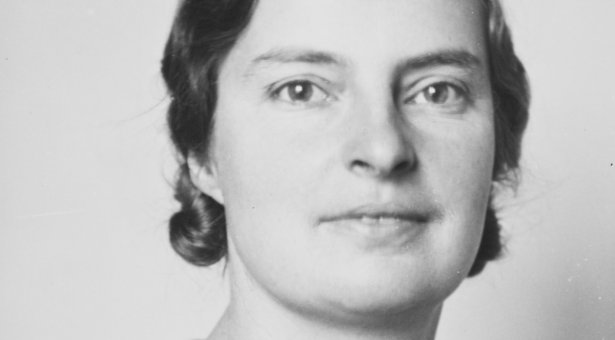Rose Scott-Moncrieff named lectures begin

Throughout the academic year, the John Innes Centre hosts a weekly programme of seminars, where we invite internationally significant plant and microbial scientists to present their work to the scientific community at the Norwich Research Park.
In 2000, the Friday seminar programme added a series of ‘Named Lectures’, in honour of people significant in the history of the John Innes Centre.
This Friday a new name will be added to the illustrious series; Rose Scott-Moncrieff.
Born in 1903, Rose Scott-Moncrieff joined the Biochemistry Department in Cambridge in 1925, after gaining a degree from Imperial College, London. Initially she was mentored by Muriel Onslow (née Wheldale) on the genetic control of pigmentation in Antirrhinum majus.
Through this work, Scott-Moncrieff gained expertise in isolating anthocyanins and in their characterisation which, at the time, involved laborious separation methods and assays of interactions with different chemicals.
In 1928 Scott-Moncrieff initiated a collaboration with Sir Robert and Lady Gertrude Robinson in Oxford who were working on chemical synthesis of anthocyanins, and who later came to be involved in surveying anthocyanins from a wide variety of plants.
While at Cambridge and encouraged by Professor JBS Haldane (a fellow recipient of a named lecture), Scott-Moncrieff linked different groups’ chemical knowledge, with her own analytical expertise and those working on genetic variation in flower colour, to form one of the very first teams working on ‘biochemical genetics’.
Initially, this collaboration between geneticists and chemists was not easy, and Scott-Moncrieff recalled that they were “at first, sceptical of each other’s methods”. JBS Haldane noted that “at an early stage, Scott-Moncrieff needed great tact in collaborating simultaneously with Sir Robert Robinson and myself”.
However, like most interdisciplinary collaborations, such scepticism disappeared once the novel insight possible from their combined approach became apparent.
Rose Scott-Moncrieff went on to join the John Innes Horticultural Institution after receiving a PhD certificate from Cambridge University (women were not allowed to join the university until 1948) in 1930.
At John Innes Horticultural Institute, Scott-Moncrieff with colleagues and collaborators published a series of ground-breaking papers between 1930 and 1940. This work identified some of the enzymes in the biochemical pathways of pigment biosynthesis in flowering plants and the genetic basis for these biochemical activities: work that was fundamental in establishing the emerging field of biochemical genetics.
Clear evidence of the relationship between genes and enzymes is given in Scott-Moncrieff’s elegant 1931 paper in Nature, ‘The chemical effect of a Mendelian factor for flower colour’. In this paper, she is the first to describe the effect of a gene from pelargonium on oxidation of the B-ring of pelargonin to form cyanin. She even suggested, by analogy to oxidases reported in animals, that this activity might involve an oxidising enzyme.
We know now that the gene she described encodes a flavonoid 3’ hydroxylase. The 1931 Nature article clearly established the concept of genes determining enzyme activity, and was subsequently supported by considerable additional research on the biochemical/genetic determinants of flower colour.
Several historians have credited the initiation of the field of biochemical genetics to Rose Scott-Moncrieff’s original mentor, Muriel Wheldale. However, though Wheldale was deeply interested in the biochemical determinants of different colour morphs in the flowers of Antirrhinum majus, the tangible advances in linking biochemistry to genetics should be attributed to Scott-Moncrieff.
In my opinion, Rose Scott-Moncrieff made a fundamental contribution to the foundation of the field of biochemical genetics. By combining the disciplines of chemistry and genetics, and working with an extremely difficult system (biochemically) she made discoveries that remain relevant and important.
For instance, many of the scientific principles described by Rose Scott-Moncrieff are particularly relevant in the rapidly growing field of natural colourants. Today anthocyanins are fast replacing synthetic colourants as safe and health-promoting natural alternatives.
Rose Scott-Moncrieff left her work at the John Innes Institute in 1937, after her marriage to Oswald Meares, an electrical engineer. Following this Rose Scott-Moncrieff travelled to India with Oswald and lived there until 1947.
While in India, in addition to bringing up two daughters, she helped with ‘investigations of camouflage’ and was Divisional Girl Guide Commissioner for Cawnpore, India. She also gained an unusual insight into the Indian education system, becoming President of the Women’s Section of the All-India Educational Conference in January 1945. Upon the family’s return to England, they settled in Guildford where Scott-Moncrieff became involved in higher education.
My own scientific course, undertaking a PhD in the Biochemistry Department of the University of Cambridge (thankfully, by my time women were awarded degrees) and then moving to a group leader position in the John Innes Centre, to work on anthocyanins for more than 30 years, has run curiously parallel to that of Rose Scott-Moncrieff. It has been an honour to research her work, and to gain a deeper understanding its considerable contribution to the field of Biochemical Genetics. This investigation has also given me the inspiration to go back and research some of the many unanswered questions that remain around flower colouration by anthocyanins.
